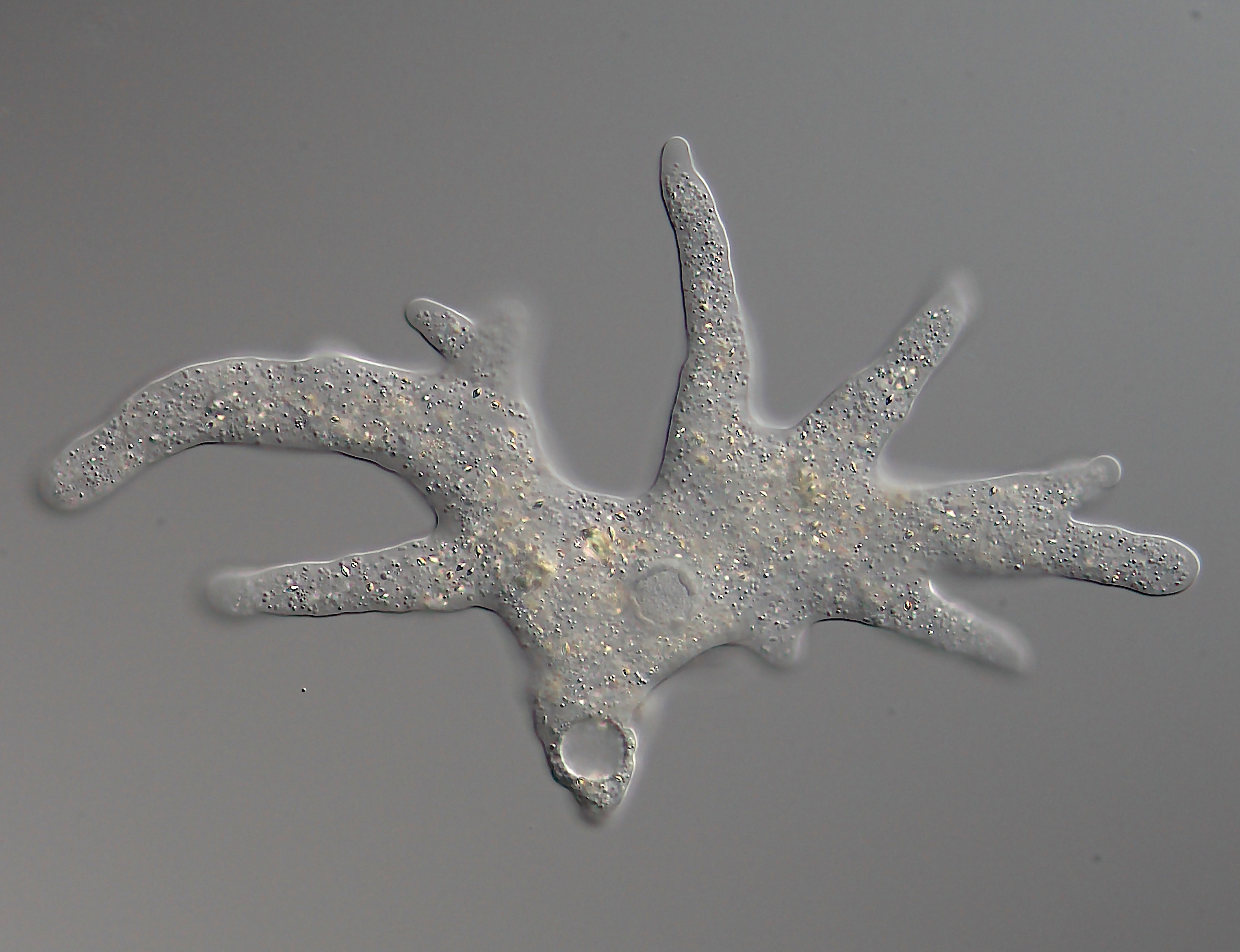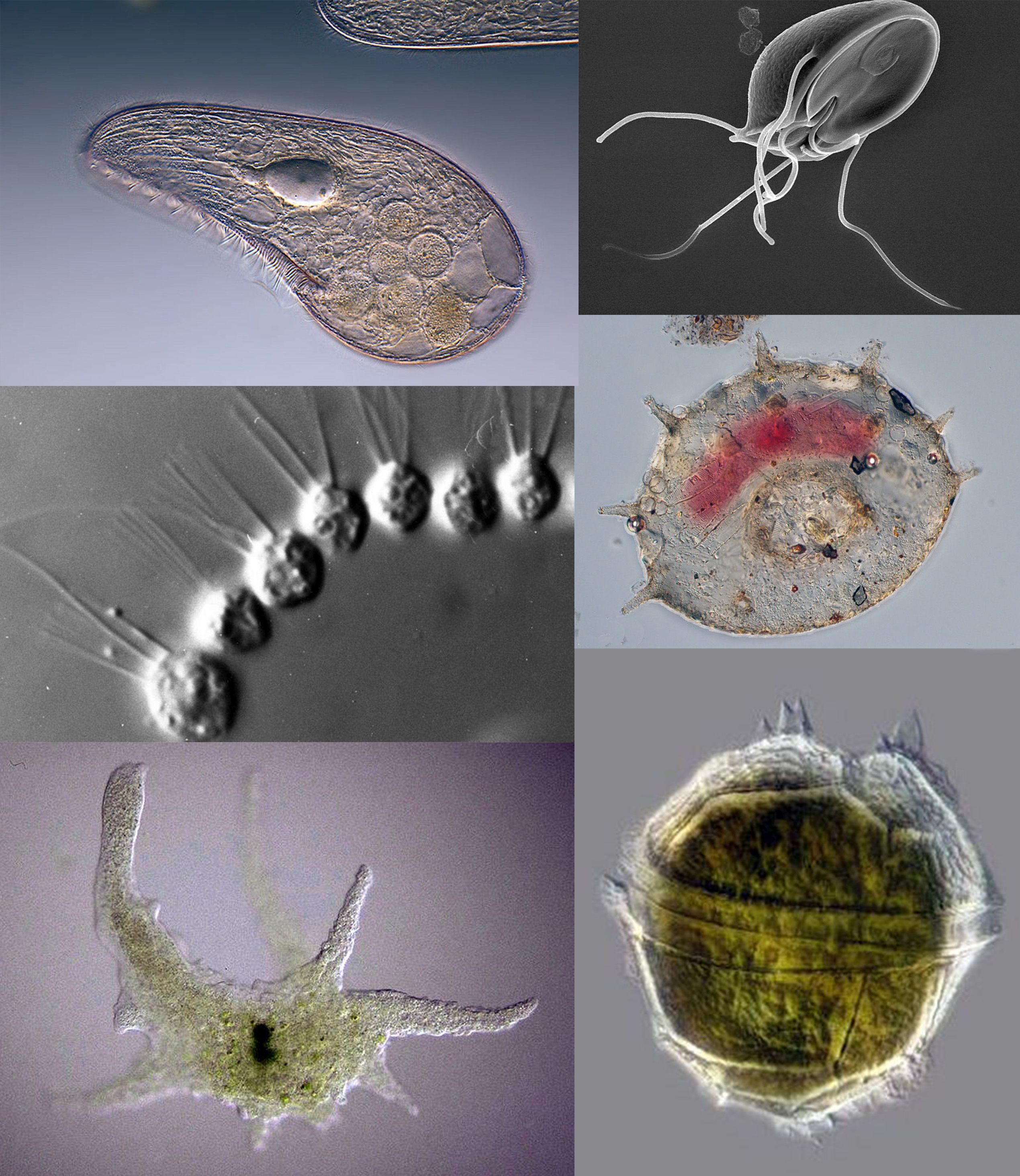|
Apusomonadida
The apusomonads (family Apusomonadidae) are a group of protozoan zooflagellates that glide on surfaces, and mostly consume prokaryotes. They are of particular evolutionary interest because they appear to be the sister group to the Opisthokonts, the clade that includes both animals and fungi. Together with the Breviatea, these form the Obazoa clade. Characteristics Apusomonads are small gliding heterotrophic biflagellates (i.e. with two flagella) that possess a proboscis, formed partly or entirely by the anterior flagellum surrounded by a membranous sleeve. There is a pellicle under the dorsal cell membrane that extends into the proboscis sleeve and into a skirt that covers the sides of the cell. Apusomonads present two different cell plans: *Derived cell plan, represented by '' Apusomonas'', with a round cell body and a mastigophore, a projection of the cell containing both basal bodies at its end. *"''Amastigomonas''-like" cell plan, with an oval or oblong cell that gener ... [...More Info...] [...Related Items...] OR: [Wikipedia] [Google] [Baidu] |
Amastigomonas
''Amastigomonas'' is a genus of protists belonging to a lineage of biciliated zooflagellates known as Apusomonadida. It was first described in 1931 by Henri de Saedeleer. The current use of ''Amastigomonas'' is as a descriptive archetype, with no phylogenetic or taxonomic implications. The term "''Amastigomonas''-like" is used to refer to all apusomonads that lack the 'derived' characteristics of '' Apusomonas''. Description Organisms under the name "''Amastigomonas''" have an oval or oblong cell that can generate pseudopodia from the ventral surface. They lack a mastigophore, a projection of the cell body that contains both basal bodies at its end. Like all Apusomonadida, they have two flagella, and the anterior flagellum is surrounded by a membranous sleeve. Current use of the name Historically, the name ''Amastigomonas'' was used for any apusomonad species that had 'primitive' characteristics compared to the more 'derived' characteristics of '' Apusomonas''. Molecular p ... [...More Info...] [...Related Items...] OR: [Wikipedia] [Google] [Baidu] |
Podomonas Kaiyoae
''Podomonas'' is a genus of apusomonads, a group of small zooflagellates that glide on their posterior cilium. The genus was identified in 2010 as an independent lineage from '' Apusomonas'' and ''Amastigomonas'', and consequently were described as their own separate taxon, containing many species previously assigned to ''Amastigomonas''. Cell structure ''Podomonas'' are ovoid or fusiform apusomonads, not divided into cell body and mastigophore. They lack a dense rod associated with the 8-microtubule band, just like '' Thecamonas'' but unlike '' Apusomonas'' and '' Manchomonas''. The ciliary sleeve is inconspicuous, around 1.5 μm long, seemingly triangular and merging into the ciliary base, pointing anteriorly or slightly to the left. The anterior cilium is strongly acronematic, unlike ''Manchomonas'', but has a non-acronematic base extending several microns beyond the sleeve tip. The posterior cilium is acronematic or tapering, with a non-acronematic portion that extends visi ... [...More Info...] [...Related Items...] OR: [Wikipedia] [Google] [Baidu] |
Obazoa
Obazoa is a proposed sister clade of Amoebozoa (which together form Amorphea). The term Obazoa is based on the OBA acronym for Opisthokonta, Breviatea, and Apusomonadidae, the group's three constituent clades. Determining the placement of Breviatea and Apusomonadida and their properties is of interest for the development of the opisthokonts in which the main lineages of animals and fungi A fungus (: fungi , , , or ; or funguses) is any member of the group of eukaryotic organisms that includes microorganisms such as yeasts and mold (fungus), molds, as well as the more familiar mushrooms. These organisms are classified as one ... emerged. The relationships among opisthokonts, breviates and apusomonads are not conclusively resolved (as of 2018), though Breviatea is usually inferred to be the most basal of the three lineages. The phylogeny of the Obazoa is shown in the cladogram. References {{Taxonbar, from=Q22087764 Amorphea taxa ... [...More Info...] [...Related Items...] OR: [Wikipedia] [Google] [Baidu] |
Protists
A protist ( ) or protoctist is any Eukaryote, eukaryotic organism that is not an animal, Embryophyte, land plant, or fungus. Protists do not form a Clade, natural group, or clade, but are a Paraphyly, paraphyletic grouping of all descendants of the last eukaryotic common ancestor excluding land plants, animals, and fungi. Protists were historically regarded as a separate taxonomic rank, taxonomic kingdom (biology), kingdom known as Protista or Protoctista. With the advent of phylogenetic analysis and electron microscopy studies, the use of Protista as a formal taxon was gradually abandoned. In modern classifications, protists are spread across several eukaryotic clades called supergroup (biology), supergroups, such as Archaeplastida (photoautotrophs that includes land plants), SAR supergroup, SAR, Obazoa (which includes fungi and animals), Amoebozoa and "Excavata". Protists represent an extremely large genetic diversity, genetic and ecological diversity in all environments, in ... [...More Info...] [...Related Items...] OR: [Wikipedia] [Google] [Baidu] |
Opisthokont
The opisthokonts () are a broad group of eukaryotes, including both the animal and fungus kingdoms. The opisthokonts, previously called the "Fungi/Metazoa group", are generally recognized as a clade. Opisthokonts together with Apusomonadida and Breviata comprise the larger clade Obazoa. Flagella and other characteristics A common characteristic of opisthokonts is that flagellate cells, such as the sperm of most animals and the spores of the chytrid fungi, propel themselves with a single ''posterior'' flagellum. It is this feature that gives the group its name. In contrast, flagellate cells in other eukaryote groups propel themselves with one or more ''anterior'' flagella. Flagellate cells however have been secondarily lost in some opisthokont groups, including most of the fungi. Opisthokont characteristics include synthesis of extracellular chitin in exoskeleton, cyst/spore wall, or cell wall of filamentous growth and hyphae; the extracellular digestion of substrates with os ... [...More Info...] [...Related Items...] OR: [Wikipedia] [Google] [Baidu] |
Apusomonas
''Apusomonas'' is a genus of Apusozoa The Apusozoa are a paraphyletic phylum of flagellate eukaryotes. They are usually around 5–20 μm in size, and occur in soils and aquatic habitats, where they feed on bacteria. They are grouped together based on the presence of an organic shel ... erected by A. G. Aléxéieff in 1924. It includes the species ''Apusomonas proboscidea''. References Apusomonadida Amorphea genera Protist genera {{Unikont-stub ... [...More Info...] [...Related Items...] OR: [Wikipedia] [Google] [Baidu] |
Pellicle (biology)
Protozoa (: protozoan or protozoon; alternative plural: protozoans) are a polyphyletic group of single-celled eukaryotes, either free-living or parasitic, that feed on organic matter such as other microorganisms or organic debris. Historically, protozoans were regarded as "one-celled animals". When first introduced by Georg Goldfuss, in 1818, the taxon Protozoa was erected as a class within the Animalia, with the word 'protozoa' meaning "first animals", because they often possess animal-like behaviours, such as motility and predation, and lack a cell wall, as found in plants and many algae. This classification remained widespread in the 19th and early 20th century, and even became elevated to a variety of higher ranks, including phylum, subkingdom, kingdom, and then sometimes included within the paraphyletic Protoctista or Protista. By the 1970s, it became usual to require that all taxa be monophyletic (derived from a common ancestor that would also be regarded as protozo ... [...More Info...] [...Related Items...] OR: [Wikipedia] [Google] [Baidu] |
Breviatea
Breviatea, commonly known as breviate amoebae, are a group of free-living, amitochondriate protists with uncertain phylogenetic position. They are biflagellate, and can live in anaerobic (oxygen-free) environments. They are currently placed in the Obazoa clade. They likely do not possess vinculin proteins. Their metabolism relies on fermentative production of ATP as an adaptation to their low-oxygen environment. The lineage emerged roughly one billion years ago, at a time when the oxygen content of the Earth's oceans was low, and they thus developed anaerobic lifestyles. Together with Apusomonads, they are the closest relatives of the Opisthokonts, a group that includes animals and fungi. Characteristics Mitochondrion-related organelles Mitochondrion-related organelles (MROs) are organelles that evolved from a degradation of ancestral, fully functional mitochondria. Among Breviatea, MROs are present in '' Pygsuia'', '' Breviata'' and '' Subulatomonas''. In the cells of '' ... [...More Info...] [...Related Items...] OR: [Wikipedia] [Google] [Baidu] |
Biflagellate
A flagellate is a cell or organism with one or more whip-like appendages called flagella. The word ''flagellate'' also describes a particular construction (or level of organization) characteristic of many prokaryotes and eukaryotes and their means of motion. The term presently does not imply any specific relationship or classification of the organisms that possess flagella. However, several derivations of the term "flagellate" (such as "dinoflagellate" and "choanoflagellate") are more formally characterized. Form and behavior Flagella in eukaryotes are supported by microtubules in a characteristic arrangement, with nine fused pairs surrounding two central singlets. These arise from a basal body. In some flagellates, flagella direct food into a cytostome or mouth, where food is ingested. Flagella role in classifying eukaryotes. Among protoctists and microscopic animals, a flagellate is an organism with one or more flagella. Some cells in other animals may be flagellate, f ... [...More Info...] [...Related Items...] OR: [Wikipedia] [Google] [Baidu] |
Protozoa
Protozoa (: protozoan or protozoon; alternative plural: protozoans) are a polyphyletic group of single-celled eukaryotes, either free-living or parasitic, that feed on organic matter such as other microorganisms or organic debris. Historically, protozoans were regarded as "one-celled animals". When first introduced by Georg Goldfuss, in 1818, the taxon Protozoa was erected as a class within the Animalia, with the word 'protozoa' meaning "first animals", because they often possess animal-like behaviours, such as motility and predation, and lack a cell wall, as found in plants and many algae. This classification remained widespread in the 19th and early 20th century, and even became elevated to a variety of higher ranks, including phylum, subkingdom, kingdom, and then sometimes included within the paraphyletic Protoctista or Protista. By the 1970s, it became usual to require that all taxa be monophyletic (derived from a common ancestor that would also be regarded as protozo ... [...More Info...] [...Related Items...] OR: [Wikipedia] [Google] [Baidu] |
Prokaryote
A prokaryote (; less commonly spelled procaryote) is a unicellular organism, single-celled organism whose cell (biology), cell lacks a cell nucleus, nucleus and other membrane-bound organelles. The word ''prokaryote'' comes from the Ancient Greek (), meaning 'before', and (), meaning 'nut' or 'kernel'. In the earlier two-empire system arising from the work of Édouard Chatton, prokaryotes were classified within the empire Prokaryota. However, in the three-domain system, based upon molecular phylogenetics, prokaryotes are divided into two domain (biology), domains: Bacteria and Archaea. A third domain, Eukaryote, Eukaryota, consists of organisms with nuclei. Prokaryotes evolution, evolved before eukaryotes, and lack nuclei, mitochondria, and most of the other distinct organelles that characterize the eukaryotic cell. Some unicellular prokaryotes, such as cyanobacteria, form colony (biology), colonies held together by biofilms, and large colonies can create multilayered microbial ... [...More Info...] [...Related Items...] OR: [Wikipedia] [Google] [Baidu] |




